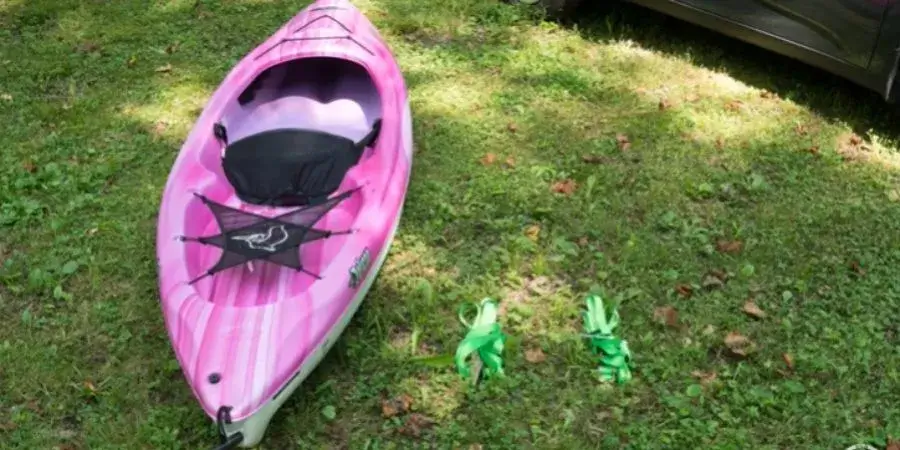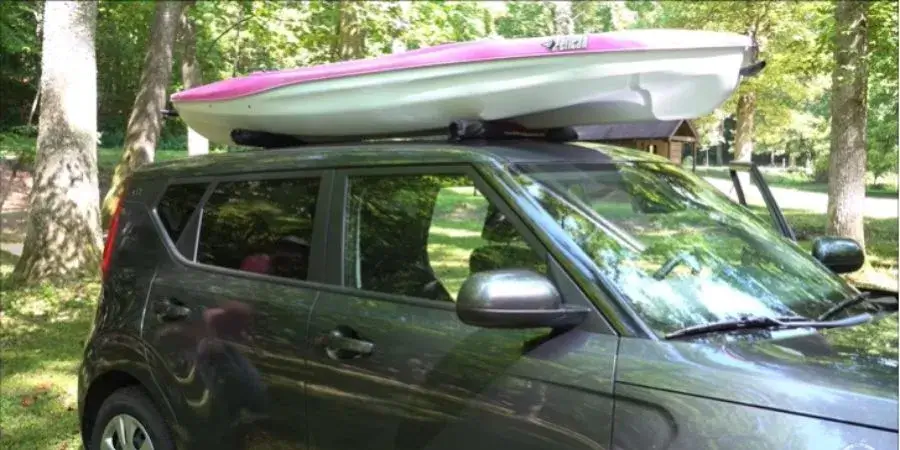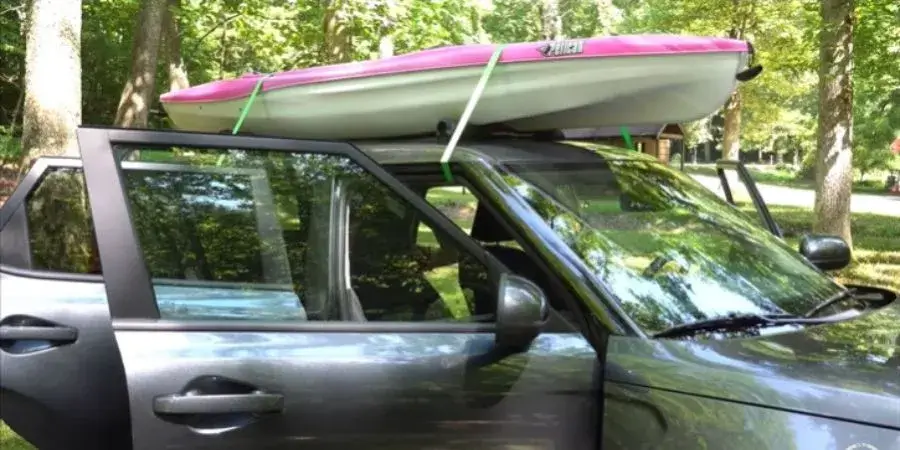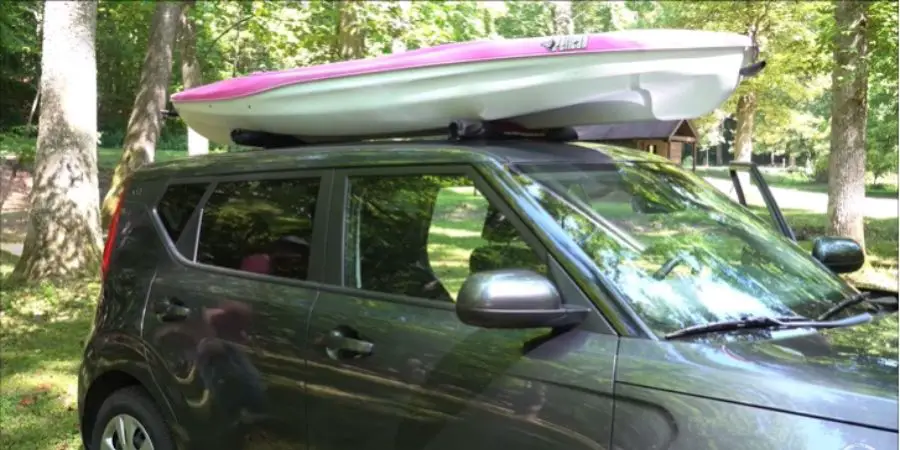Transporting a kayak without a roof rack can be done using foam blocks and straps placed on the car’s roof, ensuring the kayak is stable and secured before driving. Alternatively, using an inflatable roof rack or a trailer hitch with kayak attachments can also provide safe and effective transportation options.
How to Transport a Kayak without a Roof Rack?
You’re on the Na Pali Coast in Hawaii, enjoying crystal clear water and an open blue sky overhead as you float along. Life is beautiful, isn’t it? And of course, your highly expensive kayak makes this adventure much more fantastic.
A superior and sturdy kayak is necessary for kayaking on the water, but carrying one can be pretty complex. Are you worried about transporting your kayak? Don’t worry, my friends. I’m here to help you figure it out.
A universal roof rack is the most sophisticated way to transport a kayak. But what if you don’t have a roof rack to use? Well, other options are available, such as using pool noodles with some tie straps or even an inflatable kayak or trailer.
I’ll show you the other ways to transport your kayak without a roof rack. Let’s jump into the discussion!
How to Tie Down a Kayak without a Roof Rack
To complete this project perfectly, you will need some equipment and will have to carry out some tasks. Let’s take a look:
Step 1: Choose the Right Vehicle
The first thing you need to do is select the right vehicle. You’ll need a car or truck that can accommodate a larger kayak conveniently. Moreover, the car must have a sturdy roof, as a vehicle with an unsafetop can break down at any time if you put heavy gear like a kayak over it.
So, you should ensure that you’ve chosen a hard roof.
Step 2: Collect the Right Equipment

Pool Noodles
Pool noodles are long, cylindrical pieces of foam commonly used as buoyancy aids in swimming pools. They are typically around 5-6 feet long and can be easily manipulated to provide support while you’re swimming in the water. You can purchase them from any nearby hardware store or supermarket.
Try to buy heavy-duty and sturdy noodles because they will be more durable and provide good support in the water. Additionally, pool noodles come in different colors.
Scissors
You’ll need some scissors to cut extra parts of the noodles.
Ratchet Straps
Ratchet straps, also known as tie-down straps, are used to hold cargo or equipment in place during transportation. They typically consist of a long, flexible strap of robust nylon and a ratcheting mechanism.
This ratcheting mechanism helps tighten the strap around the object being secured.
You can easily purchase them from any automotive parts shop. Besides, you’ll probably need around four or five pairs of ratchet straps.
Rope
You’ll also need some rope. Before collecting ropes from a nearby shop, ensure they’re strong enough. Don’t go for cheaper options.
Step 3: Prepare the Kayak
Before tying down the kayak, ensure it is neat and clean. There shouldn’t be any residues left in it. Besides, you don’t want anything inside the kayak to shift during transport, which can damage the boat.
Step 4: Ready and Secure the Pool Noddles on Vehicle’s Top

First, take one pool noodle with you and throw the others onto the ground. Now, place the noodle at the edge of the car to determine its exact shape. If you see that the noodle is too long, cut off the extra portion using scissors.
It’s time to measure the second noodle. If it is also too long, there is no need to worry. Measure it with the first one and cut off the extra portion. Pool noodles are typically elastic and robust, providing a stable base for the kayak to rest on.
Now that the first pool noodle is set up, it’s time to pull one set of ratchet straps through the hole in the middle of the noodle. Run the straps through the inside of the vehicle and through the doorways to secure the noodle in place.
You can repeat the same procedure with the second noodle, placing it on the back roof. Make sure that the distance between the two kayaks is around 3-4 feet apart.
Just a reminder – before placing the two noodles on the car rooftop, it’s a good idea to spread a towel around it. This will help protect the car and kayak from scratches. Additionally, your vehicle’s roof will remain clean.
Step 5: Lifting Kayak over the Car
Now, you need to lift the kayak into your car. Some people can do it easily with their hands since they have a lot of upper body strength. But when I did it in my car, I took the quilt’s assistance to glide this thing up on top of the car.
When you are about to lift the kayak alone, there are some things you need to do in order to place it correctly. Firstly, put the yak in the center between two noddles. It would be good to keep it around two feet from the car. Then, hold one side of the kayak and slowly lift it.
You could find this challenging since keeping the balance is hard. Anyway, when you take the kayak close to the car, just push it over its roof and keep it between the two noddles.
After putting on the kayak, take off the quilt and toss it aside since you no longer need it. However, if you have muscles, you’re most welcome! You don’t need to use a quilt.
Just grab hold of your car, fling it up over your head, and put it right on top of that car. But make sure that the kayak’s seat is facing down and the bottom is facing up.
Notwithstanding, you can also take help from anybody to do it.
Step 6: Secure the Kayak with Straps
It’s time to take the straps. You need to put the straps on the other end of the car. You can easily move the straps with your finger. But, in order to do it and get the right amount of strap, you must purchase an adjustable strap from the hardware store.
To secure your kayak, place the ratchet strap over the top of the kayak’s body, in the center. Hence, you must ensure you can see both ends of the kayak from opposite sides of your car.
After that, collect the straps at each end and feed them through the front doors of your car, leaving all doors open until this step is finished.
After feeding the straps through the front doors, wrap them to reduce wind noise. This is how you can drive more smoothly and improve fuel efficiency.
Now, tighten the straps, so they are adjusted perfectly. But, don’t overtighten them since it could pose a danger to the kayak. On the other hand, keep the buckles on the outside near the kayak for easy access.
Repeat this process using the second set of straps, securing them to the back doors of your car. If you’re traveling in cold weather, there’s a possibility that the ratchet straps could gradually loosen. I experienced this while I was traveling on a Florida beach.
Fortunately, my close friend alerted me, and I had no accidents.
I guess you’re finding the whole process bit tricky. No worry! I’m making it easy for you by summarizing the procedure –
- Firstly, take the strap and check whether it is adjustable.
- Open the front door, collect the strap ends, and snatch them.
- The two straps’ ends must connect to the interior of the vehicle.
- Ensure that the buckle is situated outside.
- Enfold them and tighten them unless they’re properly secured.
- Now, open the backdoor of the car and repeat the procedure.
Is it too hard? I don’t think so! It’s convenient enough.
Step 7: Fasten the Bow and Stern Lines
Fastening the bow and stern lines with the kayak can significantly enhance its security. You can do it by using ratchet straps. These ropes should be tied to the front and back of your kayak and looped around the roof of your car. Use an anchor or a carabiner to fasten the ropes to the car.
After that, ensure they’re tight enough to prevent the kayak from shifting.
Step 8: Tie Down the Kayak

Finally, tie down the kayak using cam buckle straps. Wrap the straps around the kayak and the roof of your car. Then, use the buckle to tighten them securely. Additionally, you should ensure the straps are tight enough to prevent the kayak from shifting during transport.
However, don’t overtighten them to avoid damaging the kayak.
Step 9: Test the Ties
Before entering the street, you can test the ties by giving the kayak a good shake. If it’s secure, you’re ready to go. If it moves, adjust the ropes and straps until it is stable.
Alternative Ways to Tie Down Kayaks
Let’s find alternative ways to tie down kayaks without a roof rack. Here we go –
Inflatable Kayak
If you feel that carrying a fixed-sized kayak is a burden, another option is purchasing an inflatable kayak. They’re pretty convenient to transport and you don’t need anything or anybody’s help to do it alone.
Since it has no additional weight except the pump, transporting it is pretty trouble-free. There’s also no need to buy nylon ropes or ratchet straps. Everything is smooth and swift.
The most intriguing thing about an inflatable kayak is that it comes with a bag to store and transport it. Just throw the kayak in the car’s interior, and you’re ready to go to the beach and start kayaking.
Trailer
Before installing a roof rack on my car, one friend suggested using a trailer. However, I was reluctant to this idea because it seemed a bit old school! Anyway, my friend is still using it and doesn’t feel any shame in using it!
Although it’s not a budget-friendly option, it won’t force you to make any permanent changes to your car. To use a trailer, your vehicle must have a hitch on its back; otherwise, it’s impossible.
A kayak trailer is a fantastic option if you can overcome any potential embarrassment, as some people may find it a little embarrassing to haul equipment behind their cars. Besides, a trailer is versatile and can carry various items such as paddleboards, larger household gear, bikes, etc.
These trailers can also provide superior gas mileage. Now, the question is, how do you secure a trailer on your car? Well, it’s uncomplicated. All you need to do is include straps to help you anchor your kayak. Fasten it to your car’s hitch and start moving.
Some of the best trailers are the Ironton Folding Trailer, Malone Xtralight Trailer, etc.
Foam Car Top Carrier
Do you want to carry your kayak on the car’s roof? But, no necessary side rails/crossbars are available? Then, you can use the foam car top carrier. It could be the best solution for you. It mainly contains two foam blocks that are using ratchet straps.
The ratchet straps run through the car’s front and back inside. Then, you can place the kayak on the blocks’ top and fasten them using the straps.
Some Things to Keep in Mind with Kayak Fastening Methods
When you’re about to transport a kayak, you need to consider a few things. It doesn’t matter which methods you’re using; you must keep some important considerations in your mind –
Kayak Size and Shape
Consider the size and shape of your kayak when choosing a transportation method. Some methods may not work well for more significant or broader kayaks. Contrariwise, some may require additional equipment to accommodate a specific shape.
Weight Capacity
Make sure that your transportation method can safely support the weight of your kayak. Check the weight capacity of your roof rack, tow hitch, or other transportation equipment before loading your kayak.
Distance and Speed
Are you traveling long distances or at tremendous speeds? Then, you must ensure that the kayak is securely fastened. As a result, it won’t shift or move during transport. To do it, you can make extra tie-downs.
Weather Conditions
Take into account the weather conditions you’ll be driving in. High winds or rain can affect the stability of your kayak on top of your car. Therefore, you should ensure that it’s well-secured before hitting the road.
Local Regulations
Check local kayak transport regulations, which may vary depending on your location. Some areas may require additional safety equipment for vehicles transporting kayaks, like flags or lights.
Some Additional Tips Regarding Transporting a Kayak Correctly
Here, I’m giving you some free tips regarding perfectly transporting kayak –
- Tighten the straps perfectly and check whether the kayak is secured. However, don’t overtighten it. Otherwise, the kayak could be damaged. Since the kayak’s hulls are made of plastic, too much pressure on it could reduce its efficiency. As a result, it won’t perform well in the ocean. Thus, the risk of an accident while kayaking increases drastically.
- Climate and heat can affect the straps’ setting. It’s easy to surmise that cold temperatures have a negative impact on ratchet straps. Hence, the straps’ strength could be reduced. So, if you’re traveling long distances in a cold climate, don’t forget to check the straps regularly.
- Always use high-quality tie-down straps to secure the kayak. Don’t go for cheaper options. It could backfire badly.
- Before hitting the road, double-check that the kayak is secured correctly and that all the straps and lines are tight. A loose kayak can cause severe accidents and damage to your vehicle.
FAQs
What is a pool noodle?
A pool noodle is a long cylindrical foam material used in the pool, and it can be used to support and protect the kayak during transportation.
How do I secure the kayak without a roof rack?
You can use straps or tie-downs to secure the kayak to your car roof with the help of foam blocks or pool noodles.
How do I prevent scratches on my car while transporting a kayak without a roof rack?
You can prevent scratches on your car by using foam blocks or pool noodles between the kayak and the car roof and by securing the kayak with straps or tie-downs.
Can I transport a kayak in a pickup truck without a roof rack?
Yes, you can transport a kayak in a pickup truck without a roof rack by securing it to the truck’s bed with tie-downs or straps.
Final Words
I’ve told you about how to transport or tiedown a kayak without a roof rack in this article. You can follow these guidelines. However, from my experience, I’ll recommend you use a roof rack to carry this sports equipment. It’ll be the best option, I assure you.
Nevertheless, if you don’t have any other option, you can follow this article. In that case, you can be sure it is the most direct article. So, good luck to you. Happy kayaking!

